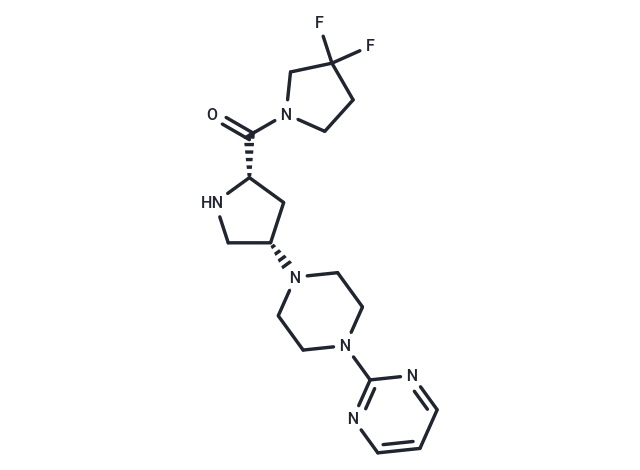Shopping Cart
- Remove All
 Your shopping cart is currently empty
Your shopping cart is currently empty

Gosogliptin is a potent, orally active, highly selective and competitive inhibitor of DPP-4 (dipeptidyl peptidase 4), increasing the levels of intestinal glucagon peptide (GLP-1) and glucose-dependent proinsulinotropic polypeptide (GIP), thereby enhancing insulin secretion and lowering blood glucose levels. In animal studies, Gosogliptin rapidly, orally and reversibly inhibits plasma DPP-4 activity.

| Pack Size | Price | Availability | Quantity |
|---|---|---|---|
| 1 mg | $139 | In Stock | |
| 5 mg | $347 | In Stock | |
| 10 mg | $556 | In Stock | |
| 25 mg | $1,160 | In Stock | |
| 50 mg | $1,870 | In Stock | |
| 100 mg | $2,500 | In Stock |
| Description | Gosogliptin is a potent, orally active, highly selective and competitive inhibitor of DPP-4 (dipeptidyl peptidase 4), increasing the levels of intestinal glucagon peptide (GLP-1) and glucose-dependent proinsulinotropic polypeptide (GIP), thereby enhancing insulin secretion and lowering blood glucose levels. In animal studies, Gosogliptin rapidly, orally and reversibly inhibits plasma DPP-4 activity. |
| In vitro | Gosogliptin is a potent, orally active inhibitor of DPP-IV, displaying over 200-fold selectivity against other DPP family members (DPP-2, DPP-3, DPP-8, and DPP-9) and related serine proteases, such as fibroblast activation protein, aminopeptidase P, and propyl oligopeptidase. This compound effectively inhibits plasma DPP-4 activity in a rapid and reversible manner following oral administration to rats, dogs, and monkeys. Gosogliptin enhances insulin secretion and glucose tolerance in various nonclinical models. Its mechanism involves competitive and selective inhibition of DPP-IV, key for degrading incretin peptides GLP-1 and glucose-dependent insulinotropic polypeptide, thereby influencing glucose homeostasis. |
| In vivo | This study aims to characterize the metabolism, pharmacokinetics, and excretion of Gosogliptin in Sprague-Dawley [rats], beagle dogs, and humans. A single oral dose of Gosogliptin is administered to SD rats (5 mg/kg), beagle dogs (5 mg/kg), and humans (20 mg). In rats, 97.1% of the administered radioactivity is recovered in urine, feces, and cage wash over 168 hours post-dose; 66.0% in feces and 30.8% in urine, with 95% excreted within 48 hours. In bile duct-cannulated rats, 29.5% is recovered in urine and 62.0% in bile. There are no gender-related differences in excretion patterns. |
| Alias | PF-734200, PF734200, PF-00734200, PF00734200 |
| Molecular Weight | 366.41 |
| Formula | C17H24F2N6O |
| Cas No. | 869490-23-3 |
| Smiles | C(=O)([C@@H]1C[C@@H](CN1)N2CCN(CC2)C=3N=CC=CN3)N4CC(F)(F)CC4 |
| Relative Density. | 1.36 g/cm3 |
| Storage | store at low temperature | Powder: -20°C for 3 years | In solvent: -80°C for 1 year | Shipping with blue ice. | |||||||||||||||||||||||||||||||||||
| Solubility Information | DMSO: 80 mg/mL (218.33 mM), Sonication is recommended. | |||||||||||||||||||||||||||||||||||
Solution Preparation Table | ||||||||||||||||||||||||||||||||||||
DMSO
| ||||||||||||||||||||||||||||||||||||

Copyright © 2015-2025 TargetMol Chemicals Inc. All Rights Reserved.